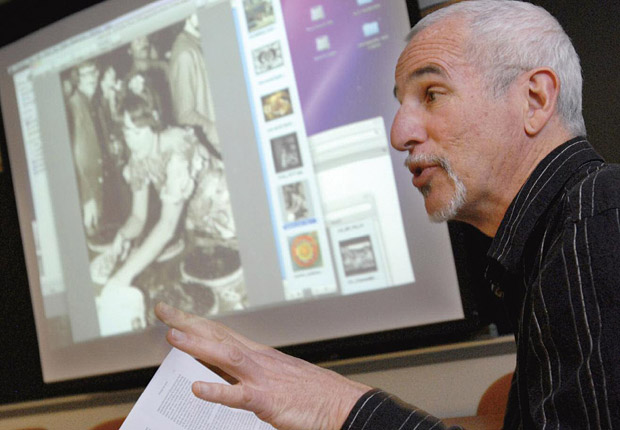 For tonight’s meeting of Professor Victor Silverman’s seminar class on California history, students were assigned to read architecture critic Reyner Banham’s influential 1971 book Los Angeles: The Architecture of Four Ecologies. An unabashed fan of L.A., the chipper British academic viewed the city through distinct “ecologies”:
For tonight’s meeting of Professor Victor Silverman’s seminar class on California history, students were assigned to read architecture critic Reyner Banham’s influential 1971 book Los Angeles: The Architecture of Four Ecologies. An unabashed fan of L.A., the chipper British academic viewed the city through distinct “ecologies”:
Surfurbia (the coast), the Plains of Id (Los Angeles Basin), the Foothills and Autopia (the freeways). But his real innovation, Silverman points out, was in the way Banham looked at Los Angeles architecture in a broad sense, giving hot dog-shaped eateries consideration along with highly-regarded landmarks such as the Modernist Eames House. In this abridged and adapted snippet of discussion, the class takes a happy detour into the quintessential L.A. topic of traffic.
SILVERMAN: Maybe we can turn now to Banham himself and to looking at what he is arguing …What did you think of the book?
LAUREN: I thought it was really interesting because it portrays Los Angeles in a positive light. Being from Los Angeles, I get a lot of crap for that. (Laughter from the class.) He looks at things that tend to be viewed in a very negative light and shows why they can be positive and how they really work in Los Angeles and how they help define it.
SILVERMAN: So what is it about L.A. that he likes that’s different than the usual?
MATT: Well, I’ve only been to L.A. proper twice. He likes L.A. for reasons I don’t like L.A. L.A. just seems vast and it’s loud and it’s smoggy and it’s kitschy. You have Hollywood and you have people in costumes …
LAUREN: Hollywood’s not actually like that. It’s one street that’s like that …
MATT (to laughter): That one street has affected my entire view … It really was not my thing but [Banham] comes through and says, well, that’s what makes Los Angeles so cool because it’s not like any other city. It doesn’t fit any archetype. I had no idea about the Watts Towers. He introduced me to the city in a way that made me step back. He takes you through the back alleyways. He shows you all these very cool architectural buildings. It made me want to see more. I want to understand L.A. for what is.
JAY: Last year I was driving on the freeway—10—to downtown L.A. I really enjoyed it because I was stuck in traffic and I’m like, OK, now I’m in L.A. It confirmed my existence in L.A: I’m in traffic, finally I can tell my friends about it. I was taking pictures of buildings around me, freeway signs. That’s a prime example of what I enjoy about L.A. There are freeways and exits all over the place. It’s just fascinating to me. And he just captures the essence of it.
SILVERMAN: Where does Banham say something that really captures that? Right in the first couple pages, right? … “The language of design architecture and urbanism in Los Angeles is the language of movement,” which is directly contradictory of what you’re saying Jay, which is that the language of Los Angeles is being stuck in traffic. (Laughter.) He goes on: ‘Mobility outweighs monumentality there to a unique degree and the city will never be fully understood by those who cannot move fluently through its diffuse urban texture … So like earlier generations of English intellectuals who taught themselves Italian in order to read Dante in the original, I learned to drive to read Los Angeles in the original.” … So then, what about the freeways?
LAUREN: If you’re from here, you just grow up with it, so it’s normal. I don’t mind traffic. It’s part of Los Angeles and [Banham] accepts that and kind of embraces that. It just becomes a part of how he’s explaining Los Angeles and why it’s different and it’s just a big part of how people function.
SILVERMAN: It’s not just how [people] function. Banham makes it one of the ecologies as well, thinking about the freeway as its own place as opposed to a means of getting from one place to another. And the fact that it’s the one ecology that is everywhere makes the freeway central to his overall point—just as it’s central to what makes L.A. L.A.
Senior Seminar on California History
The Professor
At Pomona since 1993, Professor of History Victor Silverman teaches classes on topics ranging from the labor movement to the U.S. role in the Middle East to drugs and alcohol in modern society. He earned his Ph.D. in history from UC Berkeley. An Emmy-winning filmmaker, he is also the author of three books and many articles. His latest book, California: On-the-Road Histories, will be published this summer.
The Class
From the European conquest to the current stalemated government, Californians have contended with a series of upheavals often at a great human cost. This upper-division reading seminar offers students a chance to learn the current scholarship about this tarnished Golden State.
Reading List
- Conquests and Historical Identities in California, 1769-1936, by Lisbeth Haas
- Indian Survival on the California Frontier, by Albert Hurtado
- Americans and the California Dream, by Kevin Starr
- The Conquest of Bread: 150 Years of Agribusiness in California, by Richard Walker
- Los Angeles: The Architecture of Four Ecologies, by Reyner Banham
- Suburban Warriors—The Origins of the New American Right, by Lisa McGirr
- Guest Workers or Colonized Labor?: Mexican Labor Migration to the United States, by Gilbert Gonzalez
